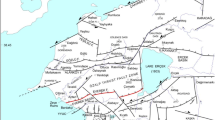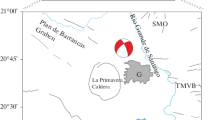Abstract
This study aims to investigate a Mw 6.8 earthquake that occurred in Myanmar on 24 March 2011. The epicenter of this earthquake struck very close to the Tarlay town which is located near the border of Myanmar, Lao People’s Democratic Republic (PDR), and Thailand. In addition, this shallow left-lateral strike-slip earthquake occurred on Nam Ma fault which is previously identified as an active fault. Based on instrumental earthquake catalogue, Nam Ma fault did not produce any earthquake greater than magnitude 6 for at least 100 years. So the 24 March 2011 earthquake is essentially filling the gap of relatively short instrumental earthquake catalogue in this region. The strong ground motion from this event has been recorded in Thailand with the highest peak ground acceleration (PGA) of 0.20 g at 28 km distance at Mae Sai town. Comparison between observed strong motion and global empirical equation had been provided. Over the distance range for which the model is applicable, they are in fair agreement. On the other hand, at long distance, the large positive and negative residuals suggest that a change in slope in the attenuation is not reflected in these relations. Lastly a seismological aspect of strong ground motion at Mae Sai had been given.
Similar content being viewed by others
References
Abrahamson NA (2000) Near-fault ground motions from the 1999 Chi-Chi earthquake. In: Proceedings of U.S.–Japan workshop on the effects of near-field earthquake shaking. San Francisco, California, 20–21 March 2000
Akkar S, Özen Ö (2005) Effect of peak ground velocity on deformation demands for SDOF systems. Earthq Eng Struct Dyn 34(13): 1551–1571
AIT: (1980) Asian Institute of Technology, “Investigation of Land Subsidence Caused by Deep Well Pumping in the Bangkok Area, Phase II”. AIT research report submitted to the National Environmental Board, Thailand
Bilham R (2004) Earthquakes in India and the Himalaya: tectonics, geodesy and history. Ann Geophys 47(2): 839–858
Boore DM, Atkinson GM (2008) Ground-motion prediction equations for the average horizontal component of PGA, PGV, and 5%-damped PSA at spectral periods between 0.01 s and 10.0 s. Earthq Spectra 24: 99–138
Bouchon M, Bouin M-P, Karabulut H, Toksoz MN, Dietrich M, Rosakis AJ (2001) How fast is rupture during an earthquake? New insights from the 1999 Turkey earthquakes. Geophys Res Lett 28: 2723–2726
DPT 1302 (2009) Seismic resistant design of buildings and structures. Department of Public Works and Town & Country Planning, Ministry of Interior, p 125 (in Thai)
Fenton CH, Charusiri P, Wood SH (2003) Recent paleoseismic investigations in northern and western Thailand. Ann Geophys 46: 957–981
Giardini D, Grunthal G, Shedlock K, Zheng P (1999) The GSHAP global seismic hazard map. Annali di Geofisica 42: 1225–1230
Kagawa T, Irikura K, Somerville PG (2004) Differences in ground motion and fault rupture process between the surface and buried rupture earthquakes. Earth Planets Space 56: 3–14
Kawase H, Aki K (1990) Topography effect at the critical SV-wave incidence: possible explanation of damage pattern by the Whittier Narrows, California, earthquake of 1 October 1987. Bull Seismol Soc Am 80: 1–22
Knopoff L (1958) Energy release in earthquakes. Geophys J 1: 44–52
Lacassin R, Replumaz A, Hervé Leloup P (1998) Hairpin river loops and slip-sense inversion on southeast. Asian Strike Slip Faults Geol 26(8): 703–706
Lin J, Stein RS (2004) Stress triggering in thrust and subduction earthquakes, and stress interaction between the southern San Andreas and nearby thrust and strike-slip faults. J Geophys Res 109: B02303. doi:10.1029/2003JB002607
Mavroeidis GP, Papageorgiou AS (2003) A mathematical representation of near-fault ground motions. Bull Seismol Soc Am 93(3): 1099–1131
Oglesby DD, Archuleta RJ (1997) A faulting model for the 1992 Petrolia earthquake: can extreme ground acceleration be a source effect?. J Geophys Res 102: 11877–11897
Okada Y (1992) Internal deformation due to shear and tensile faults in a half-space. Bull Seismol Soc Am 82(2): 1018–1040
Ornthammarath T, Warnitchai P, Worakanchana K, Zaman S, Sigbjörnsson R, Lai CG (2011) Probabilistic seismic hazard assessment for Thailand. Bull Earthquake Eng 9(2): 367–394
Palasri C, Ruangrassamee A (2010) Probabilistic seismic hazard maps of Thailand. J Earthq Tsunami 4(4): 369–386
Parsons T, Stein RS, Simpson RW, Reasenberg PA (1999) Stress sensitivity of fault seismicity; a comparison between limited-offset oblique and major strike-slip faults. J Geophys Res 104(B9): 20183–20202
Poovarodom N, Pitakwong K (2010) Microtremor observations for site characterization in Thailand. In: Proceeding of the 3rd Asia conference on earthquake engineering (ACEE2010):1–3 December 2010
Radiguet M, Cotton F, Manighetti I, Campillo M, Douglas J (2009) Dependency of near-field ground motions on the structural maturity of the ruptured faults. Bull Seismol Soc Am 2572–2581. doi:10.1785/0120080340
Ruangrassamee A, Ornthammarath T, Lukkunaprasit P (2012) Damage due to 24 March 2011 M6.8 Tarlay earthquake in Northern Thailand. In: Proceeding of the 15th world conference in earthquake engineering (15WCEE):Lisbon, Portugal, September 24–28, 2012
Rupakhety R, Halldorsson B, Sigbjornsson R (2010) Estimating coseismic deformations from near source strong motion records: methods and case studies. Bull Earthquake Eng 8(4): 787–811. doi:10.1007/s10518-009-9167-9
Sadigh K, Chang C-Y, Egan JA, Makdisi FI, Youngs RR (1997) Attenuation relationships for shallow crustal earthquakes based on California strong motion data. Seismol Res Lett 68(1): 180–189
Shen Z-K, Lu J, Wang M, Burgmann RC (2005) Contemporary crustal deformation around the southeast borderland of the Tibetan Plateau. J Geophys Res 110: B11409. doi:10.1029/2004JB003421
Sigurdsson SU, Rupakhety R, Sigbjornsson R (2011) Adjustments for baseline shifts in far-fault strong-motion data: an alternative scheme to high-pass filtering. Soil Dyn Earthq Eng 31(12): 1703–1710
Stein S, Wysession M (2003) An introduction to seismology, earthquakes, and earth structure. Blackwell, ISBN 0-86542-078-5
Toda S, Stein RS (2002) Response of the San Andreas fault to the 1983 Coalinga-Nuñez earthquakes: an application of interaction-based probabilities for Parkfield. J Geophys Res 107. doi:10.1029/2001JB000172
Uttamo W, Elders CF, Nicols GJ (2003) Relationships between Cenozoic strike-slip faulting and basin opening in northern Thailand, in Intraplate Strike-Slip Deformation Belts, edited by F. Storti et al. Geol Soc Spec Publ 210: 89–108
Wald DJ, Quitoriano V, Heaton TH, Kanamori H (1999) Relationships between peak ground acceleration, peak ground velocity, and Modified Mercalli intensity in California. Earthq Spectra 15(3): 557–564
Wells DL, Coppersmith KJ (1994) New empirical relationships among magnitude, rupture length, rupturewidth, and surface displacements. Bull Seismol Soc Am 84(4): 974–1002
Worden CB, Gerstenberger MC, Rhoades DA, Wald DJ (2012) Probabilistic relationships between ground-motion parameters and modified mercalli intensity in California. Bull Seismol Soc Am 102(1): 204–221
Author information
Authors and Affiliations
Corresponding author
Rights and permissions
About this article
Cite this article
Ornthammarath, T. A note on the strong ground motion recorded during the Mw 6.8 earthquake in Myanmar on 24 March 2011. Bull Earthquake Eng 11, 241–254 (2013). https://doi.org/10.1007/s10518-012-9385-4
Received:
Accepted:
Published:
Issue Date:
DOI: https://doi.org/10.1007/s10518-012-9385-4




